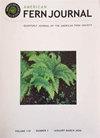中国蕨类属喀斯特和达尼沙特有种配子体发育
IF 0.9
4区 生物学
Q4 PLANT SCIENCES
引用次数: 0
摘要
摘要铁线蕨系Gravesiana(蕨类植物科)蕨类植物主要分布在丹霞(A.parasititum)和喀斯特(A.mariesii、A.longzhouensis、A.dentatum、A.obovatum和A.gravesii)地貌上。我们在琼脂和土壤上培养了来自20个不同种群的这6个物种的代表,以研究和比较它们的配子体发育。除A.obovatum外,所有物种都具有Vittaria型孢子萌发模式,我们错过了观察这一发育阶段的最佳时间。然而,观察到了两种不同的后续发育模式:滨海A.mariesii、龙洲A.parasititum中的铁线藻型(即裸露的心形成熟配子体铊),齿形A.dentatum和倒卵A.obovatum中的gravesii和Kaulinia型(即赤裸的带状成熟配子体菌体)。并置A.parasititum和gravesii的所有种群都具有相同的铁线蕨类型,这表明喀斯特和丹霞土壤不是导致配子体发育差异的主要因素。Kaulinia型成年铊以前从未在铁线蕨中观察到,与该系列的其他成员相比,它可能是在齿A.dentatum和倒卵A.obovatum所经历的相对恶劣的微栖息地中生存的一种适应性策略。本文章由计算机程序翻译,如有差异,请以英文原文为准。
Gametophyte Development of Karst- and Danixa-Specific Species of Adiantum Series Gravesiana (Pteridaceae) from China
Abstract. The ferns of Adiantum Series Gravesiana (Pteridaceae) consist of species that occur exclusively on Danxia (A. juxtapositum) and Karst (A. mariesii, A. longzhouensis, A. dentatum, A. obovatum, and A. gravesii) landforms. We cultured representatives of these six species from 20 different populations on both agar and soil to investigate and compare their gametophyte development. All species had the Vittaria-type pattern of spore germination except A. obovatum, for which we missed the best time to observe this developmental phase. However, two different patterns of subsequent development were observed: the Adiantum-type (i.e., naked, cordate mature gametophyte thallus) in A. mariesii, A. longzhouensis, A. juxtapositum, and A. gravesii and the Kaulinia-type (i.e., naked, ribbon-shaped mature gametophyte thallus) in A. dentatum and A. obovatum. All populations from A. juxtapositum and A. gravesii possess the same Adiantum-type, suggesting that Karst and Danxia soils were not the main factor causing the differences in gametophyte development. The Kaulinia-type adult thallus has not been observed previously in Adiantum and may be an adaptive strategy for survival within the relatively harsh micro-habitats experienced by A. dentatum and A. obovatum compared to other members of this series.
求助全文
通过发布文献求助,成功后即可免费获取论文全文。
去求助
来源期刊

American Fern Journal
生物-植物科学
CiteScore
1.20
自引率
0.00%
发文量
28
审稿时长
6 months
期刊介绍:
The American Fern Journal is a peer-reviewed journal focused on the biology of ferns and lycophytes.
 求助内容:
求助内容: 应助结果提醒方式:
应助结果提醒方式:


